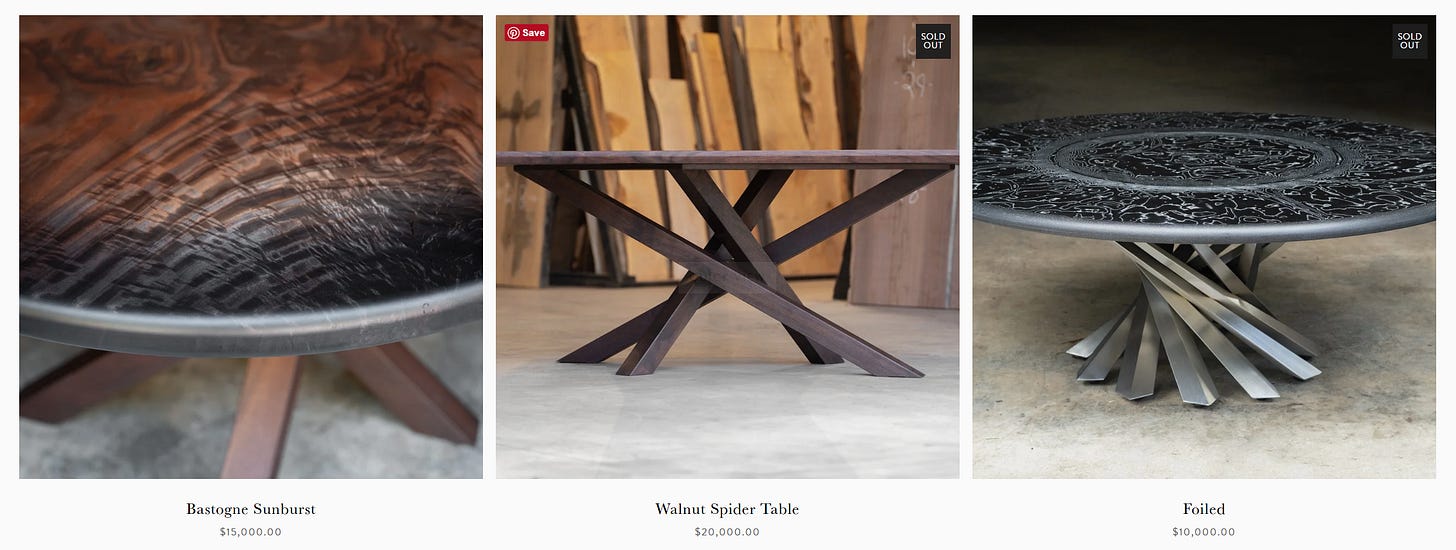The Best Business Model - 4x Leverage & Edge principles
Better to be a mile deep than an inch wide.
On this site I’m always talking about businesses or income producing methods that follow the edge principles.
These are essentially models where you create one specialized edge (or input) you can repeat and earn from for a long period of time.
So instead of leveraging labour or time daily you can leverage the “value” you created in the past in the future.
But don’t mistake this for passive income.
Edges are still active, they can obviously be passive as well but are most commonly where skills meet process meet automation or leverage.
Edges can be creative marketing strategies that work every single time (a process, automated or not), information asymmetry, pure edges such as those in sports betting or even things like automated trading bots, fully managed airbnb assets etc.
But think of edges more in the “process that sets up a fully managed airbnb” rather than the thing itself.
Someone who did this once is not impressive.
If you did this 40 times, that’s impressive.
Today we’re on about an interesting business model that combines some of the elements I’ve been thinking through and how in some very unique circumstances you can get multiple knock-on effects by doing the same thing.
Creators (Done Right)
YouTubers or influencer-first-creators are pretty cringe.
Anyone who responds to the what-do-you-do question with influencer or Youtuber is generally someone who isn’t going to fall into this model.
Instead I’m talking about creator-first channels who then leverage really nice business models on both the front end and back-end, and in some cases have additional benefits by doing the thing anyway.
The Four-Fold Best Business Model Example
The best example of this I’ve seen is in the woodworking niche, with a channel called Blacktail Studios, it’s a guy called Cam who creates high quality, full furniture-build type videos and does this in an entertaining and well-edited way.
1.) YouTube Ad Revenue
This is one of four monetisation methods for this channel (YouTube ad revenue, this would also be streamer income/donations in a different field).
I don’t love this approach when creators start a channel purely for this monetisation.
2. Selling the Physical Product
The second monetisation method is that because you’ve got this piece of custom, really high end furniture you’ve built (and documented) and have a channel of followers who like woodworking/you/furniture. You now actually have an automatic audience to sell said project very easily.
Usually for low five figures.
This is the start of the genius or just the reason why I think woodworking examples work so well in this area, is that people don’t care if you’ve done something in 3 hours, but if you’ve taken a month to build a fully custom piece of furniture, thousands of dollars in costs, hundreds of hours in building and crafting and probably dozens more of video editing and audio voice overs… You have something of value.
But you actually get 2 things out of it.
If someone creates an awesome piece of content, of the same length, in a similar niche, let’s just say its more of a how-to type video, at the end of all that work, you don’t have a five figure table to sell.
You don’t get this secondary benefit that has a doubly-high perceived value.
So now we have; YouTube monetisation + A nice fuck off table/desk/furniture we can sell (to our already impressed/interested audience).
Of which, two of his three most recent projects have already sold for five figures it looks like.
3. Niche-Specific Sponsorships
The third angle is niche-specific sponsorships - These are great because they are long-term and real rather than the quite irrelevant ads or sponsorships you see in a lot of videos.
In this example I believe he’s sponsored by some tool companies (and just gives them a shoutout whenever he uses said tools) as well as Epoxy, which is super expensive so having a sponsorship for that probably saves a ton even if he’s only paid in free epoxy.
These work best when you actually use and would-use the products you discuss and are paid for.
Obviously.
Otherwise you’re just a shill.
4. Building a Brand/Business
The fourth is simply to build a niche-business off the back of your audience.
This is what I think some youtube channels get really wrong, despite still being successful with it in some cases.
There’s builder/maker type channels that have really overpriced products and treat these almost like donations.
Meaning if your audience wouldn’t buy-the-product-anyway, then it’s probably a pretty bad deal.
You are seeing a lot of these low quality food and beverage type products come through the lines from these influencers that have nothing to do with their actual brands or following.
In the Blacktail studio example he’s launched some higher end wood finishing products with some other more niche products such as a "Damascus Precision Edge Marking Knife".
The difference really is that there just seems to be some actual effort gone into this being a real brand created by the creator themselves.
Similar to another woodworker who launched a wood finishing product (that's different) called sample 73. Again done very well and I actually believe he created this, launched it, tested it etc.
They bring you on the journey of the build and it actually makes sense for their brand.
It’s not a pump and dump money grab from a greedy, almost predatory content creator, usually fueled by, let’s call it young or dumb money.
5.) Options
What makes this even better is if you want to be purely a content creator, you can ignore part 4.
If you don’t want the stress of building a brand or business around your audience or channel, then don’t.
Or just go with option 1 and 4, pushing part 4 “building the brand” in the right way.
There’s other YouTubers that have done this “part 4” of create a brand around your audience really well.
Such as Gotham Chess with his chess learning platform Chessly, and Mark Rober making kids smart again with Crunch Labs.
Both really well done but they don’t get that added benefit(s) of the part 2 and 3.
Especially the idea around “in the video creation process, you end up with something of massive value”.
I think people try to fast track this by actually trying to leverage this idea but simply spend 1 day, when they should have spent 30 or a piece of content.
Depth is appreciated over breadth as well.
Most people (me included) will be interested about someone who is the-best at a particular skill or thing.
Almost regardless of the thing if the context and content it is provided in is entertaining or informative.
This is why depth is so much more essential.
Depth or specialized knowledge, whatever you want to term it.
Actually even more so with AI taking over and speeding up progress.
If you have depth of knowledge already, AI super-powers your ability to create with that depth, but if you have only a one-inch knowledge of many things, you are literally replaced instantly by it.
Better to be a mile deep than an inch wide.
A lot of people are talking about how it’s better to be a generalist now than a specialist because of AI.
I think this is backwards.
AI still can’t go out and understand what ratings and calibrations I need for a sports betting model, or what’s more important batting or bowling in cricket?
But it can build me scrapers to collect data and write scripts to answer these questions.
But it doesn’t know what questions to try answer in each niche yet.
I also think this is why our woodworking example works so well.
With all the improvements in AI generative video, I think people are craving a bit of mastery-to-craft content, especially when it’s authentic.
Woodworking works so well in this example because it hits all these points.
The product that’s created is physical, it’s a very tangible end product, it also has a higher perceived value (one of a kind, tons of hours input, custom) both physically and on the content creation side.
It’s just more real.
I struggled to think of more examples around this without it feeling gimmicky, and as always there are caveats.
Caveats
Yes, you have to grow the audience
Yes, it’s difficult and time consuming to develop videos for months and probably years before you get anywhere remotely close to these numbers.
Yes, there are start-up costs.
Yes, there is a ton of competition.
But this is the same with all businesses.
There’s always tons of competition, costs and you start from zero anyway.
But if you can think about these future avenues it’ll motivate you (and me) to continue towards mastery of the craft, rather than just thinking purely about money.
There's a quote from Robert Greene's Mastery that's baked into my brain:
However long your project takes to complete, you will always experience a sense of impatience. The single greatest action you can take to acquire creative power is to reverse this natural impatience. You take pleasure in the laborious research process. Time is in fact your greatest ally.
This is really good advice.
Almost impossible to remember most of the time as well.
Personally I haven’t drawn the lines to my personal four-factor business model approach yet, I’m trying to get some ideas and think about how all the different skills and projects through the years can merge into this really nice creator, mastery evolving, multiple leveraged structure… Haven’t got there yet but open to ideas.
The last point I couldn’t fit anywhere else as well is within the mastery of craft 4-factor approach, every time you do this you become better at your craft, so when you approach it as mastery of your craft, business, video editing, brand, product creation, marketing, audience retention and everything associated, if you treat it as mastery towards said craft there’s less pressure and you feel less rushed.
Time is in fact your greatest ally.
Cheers.



